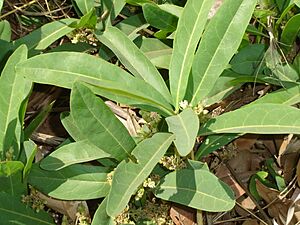Sodium monofluoroacetate facts for kids
Sodium fluoroacetate is a chemical compound. It's a type of poison that can harm many living things. Sometimes, this chemical is used in poisons to control rodents like rats and mice. Scientists also use tiny amounts of it to help find cancer cells in medical scans called Positron Emission Tomography (PET scans). Because they use such small amounts, the poison part isn't a problem for medical use.
Contents
Where Does Sodium Fluoroacetate Come From?
Sodium fluoroacetate is found naturally in at least 40 different types of plants. These plants grow in places like Australia, Brazil, and Africa.
Scientists first found this chemical in a plant called the poison leaf, or Dichapetalum cymosum, in 1944. This plant is also known as "gifblaar." Even before that, in 1904, people in Sierra Leone used parts of another plant, Chailletia toxicaria, to poison rats. This plant also contains fluoroacetic acid or its related salts.
Many native Australian plants also have this toxin. Some of these include types of Gastrolobium, Gompholobium, Oxylobium, Nemcia, and Acacia plants. These plants use the chemical as a way to protect themselves from animals that might try to eat them.
How is Sodium Fluoroacetate Used?
This chemical is mainly known for its use as a pesticide. It helps control populations of animals that are considered pests, especially rodents. For example, in New Zealand, it's used to manage populations of animals like possums that can harm native plants and animals.
Scientists also use very small amounts of sodium fluoroacetate in medicine. They use it as a special marker to help find cancer cells during certain medical tests. This helps doctors see where cancer might be in the body.
Images for kids
See also
 In Spanish: Fluoroacetato de sodio para niños
In Spanish: Fluoroacetato de sodio para niños




